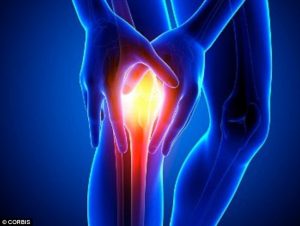Arthritis is often referred to as if it was one disease or condition. In fact,  arthritis is a family of over 100 different conditions that effect the musculoskeletal systems of the body, particularly the joints. Typically, arthritic conditions tend to effect the cartilage covering of the joints, often resulting in inflammation and damage to this cartilage covering. This cartilage acts as a protective cushioning on the ends of the bone, which allow the joint to glide smoothly. Damage to this cartilage covering often results in stiff and painful movement of the joint.
arthritis is a family of over 100 different conditions that effect the musculoskeletal systems of the body, particularly the joints. Typically, arthritic conditions tend to effect the cartilage covering of the joints, often resulting in inflammation and damage to this cartilage covering. This cartilage acts as a protective cushioning on the ends of the bone, which allow the joint to glide smoothly. Damage to this cartilage covering often results in stiff and painful movement of the joint.
There are many types of arthritis, with perhaps the most well know being osteoarthritis. Osteoarthritis is different from all other forms of arthritis in that it is essentially wear and tear to the cartilage covering of the joints which has occurred over quite a long period of time. This may develop for a number of reasons such as being overweight and thus placing more load and stress onto the joint surface, previous injury to the joint which as damaged the cartilage, weak muscles which result in poorly controlled movement of the joint, lots of repetitive loading of a particular joint of the body and a genetic predisposition to having cartilage which wear more easily. The most commonly effected joints and the knee, hip and spine.
There is no cure for osteoarthritis. Once the cartilage has been worn, it does not regenerate. Treatment focuses largely on controlling the symptoms with medication such as anti-inflamatories as well as activity modification to reduce stress and load on the effected joint. One of the most important parts of treating osteoarthritis is exercise in order to maintain adequate muscle strength for well controlled loading of the joint. This prevents or slows the rate of further wear to the cartilage.
All of the remaining forms of arthritis involve a systemic disease process or condition in the body, which results in the immune system attacking the joints, resulting in inflammation, stiffness and pain. These systemic arthritic conditions include, rheumatoid arthritis, ankylosising spondylitis, reactive arthritis and juvenile arthritis and all involve a different underlying disease process. Because each of these conditions involves a different pathology, they effect different areas of the body. Typically, rheumatoid arthritis effects the smaller joints of the body such as the fingers and toes first. Ankylosing spondylitis tends to mainly effect the spine.
The first line in management of these conditions involves prescription of appropriate medication in an attempt to address each underlying pathology and decrease it effect on the joints. Just as with osteoarthritis, activity modification as well as exercises to maintain the strength of the muscles which control the joints is essential. With these types of arthritic conditions, generally involvement of a rheumatologist to advise on the best medication and course of management is an important part of the patient treatment.
